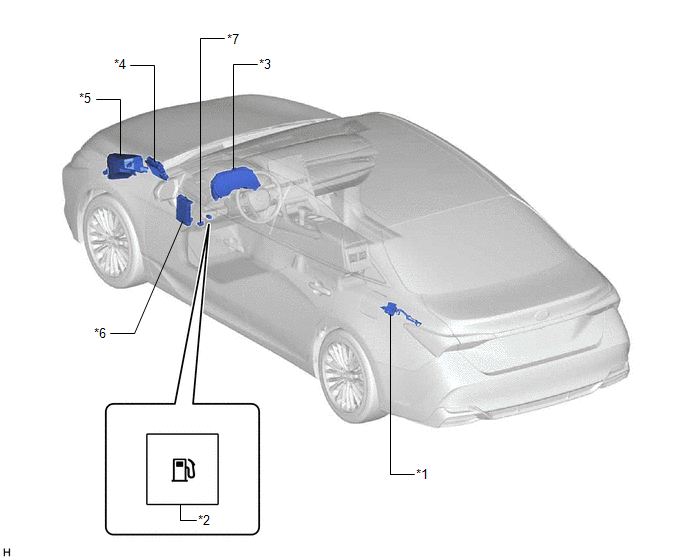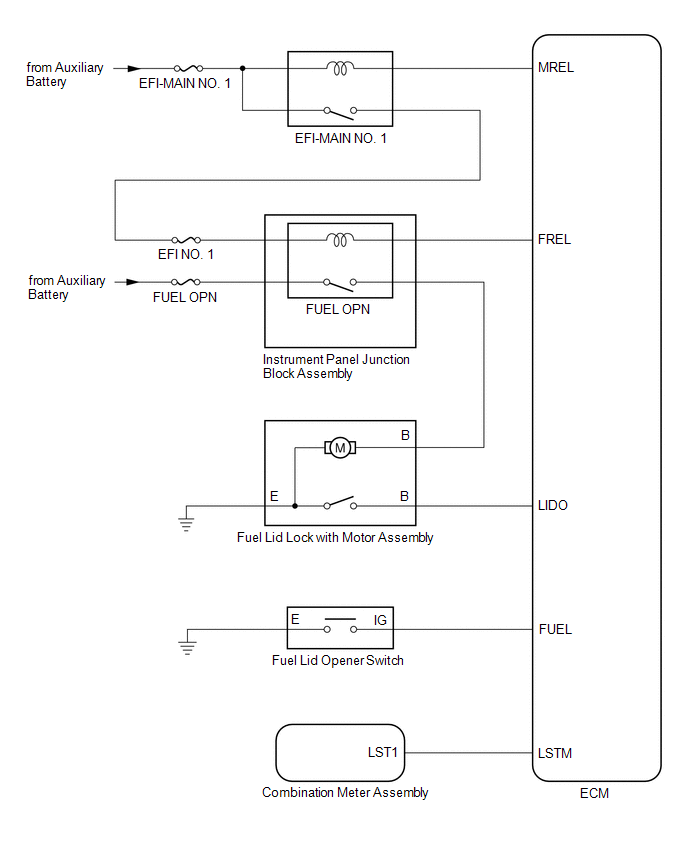Data List / Active Test
DATA LIST / ACTIVE TEST
NOTICE:
In
the table below, the values listed under "Normal Condition" are
reference values. Do not depend solely on these reference values when
deciding whether a part is faulty or not.
HINT:
Using
the Techstream to read the Data List allows the values or states of
switches, sensors, actuators and other items to be read without removing
any parts. This non-intrusive inspection can be very useful because
intermittent conditions or signals may be discovered before parts or
wiring is disturbed. Reading the Data List information early in
troubleshooting is one way to save diagnostic time.
DATA LIST
(a) Connect the Techstream to the DLC3.
(b) Turn the power switch on (IG).
(c) Turn the Techstream on.
(d) Enter the following menus: Powertrain / Engine / Data List.
(e) Read the Data List according to the display on the Techstream.
Powertrain > Engine > Data List
|
Tester Display | Measurement Item |
Range | Normal Condition |
Diagnostic Note |
|
Fuel Filler Opener | Fuel lid lock with motor assembly status |
OFF or ON | OFF: Fuel lid lock with motor assembly not operating
ON: Fuel lid lock with motor assembly operating |
- |
| Fuel Lid SW |
Fuel lid opener switch status |
Close or Open | Close: Fuel lid opener switch not pushed
Open: Fuel lid opener switch pushed |
- |
| Fuel Lid Sensor SW |
Fuel lid courtesy switch status |
Close or Open | Close: Fuel lid closed
Open: Fuel lid open | - |
HINT:
Using
the Techstream to perform Active Tests allows relays, VSVs, actuators
and other items to be operated without removing any parts. This
non-intrusive functional inspection can be very useful because
intermittent operation may be discovered before parts or wiring is
disturbed. Performing Active Tests early in troubleshooting is one way
to save diagnostic time. Data List information can be displayed while
performing Active Tests.
ACTIVE TEST
(a) Connect the Techstream to the DLC3.
(b) Turn the power switch on (IG).
(c) Turn the Techstream on.
(d) Enter the following menus: Powertrain / Engine / Active Test.
(e) Perform the Active Test according to the display on the Techstream.
Powertrain > Engine > Active Test
|
Tester Display | Measurement Item |
Control Range | Diagnostic Note |
|
Activate the Fuel Filler Opener |
Fuel lid lock with motor assembly |
OFF/ON | - |
Fuel Lid Opener does not Operate
DESCRIPTION
When the fuel
lid opener switch is pushed, a fuel lid opener switch signal is sent to
the ECM. The ECM turns on the FUEL OPN relay and EFI-MAIN relay, and the
fuel lid lock with motor assembly opens the fuel lid. When the fuel lid
is open, a fuel lid courtesy switch signal is output from the fuel lid
lock with motor assembly.
WIRING DIAGRAM
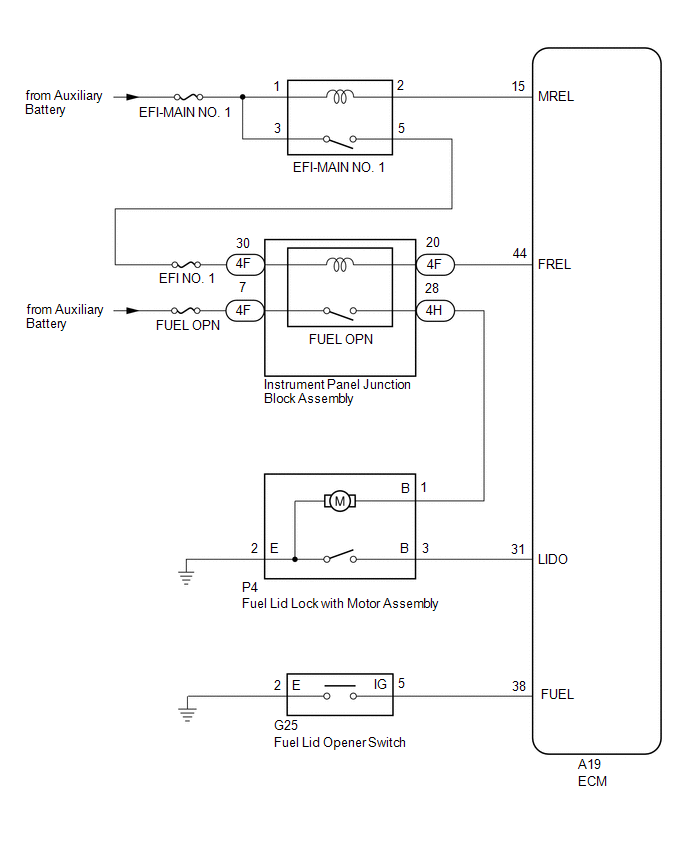
CAUTION / NOTICE / HINT
NOTICE:
Inspect the fuses for circuits related to this system before performing the following procedure.
PROCEDURE
| 1. |
CHECK FOR DTC (SFI SYSTEM) |
(a) Connect the Techstream to the DLC3.
(b) Turn the power switch on (IG).
(c) Turn the Techstream on.
(d) Check for DTCs.
Powertrain > Engine > Trouble Codes
OK:
SFI system DTCs are not output.
| NG |
 | GO TO SFI SYSTEM |
|
OK |
 | |
| 2. |
PERFORM ACTIVE TEST USING TECHSTREAM (Activate the Fuel Filler Opener) |
(a) Enter the following menus: Powertrain / Engine / Active Test.
(b) Perform the Active Test according to the display on the Techstream.
Powertrain > Engine > Active Test
|
Tester Display | Measurement Item |
Control Range | Diagnostic Note |
|
Activate the Fuel Filler Opener |
Fuel lid lock with motor assembly |
OFF/ON | - |
Powertrain > Engine > Active Test
|
Tester Display |
| Activate the Fuel Filler Opener |
OK:
The fuel lid lock with motor assembly operates normally.
| NG |
 | GO TO STEP 9 |
|
OK |
 | |
| 3. |
READ VALUE USING TECHSTREAM (Fuel Lid SW) |
(a) Enter the following menus: Powertrain / Engine / Data List.
(b) Read the Data List according to the display on the Techstream.
Powertrain > Engine > Data List
|
Tester Display | Measurement Item |
Range | Normal Condition |
Diagnostic Note |
|
Fuel Lid SW | Fuel lid opener switch status |
Close or Open | Close: Fuel lid opener switch not pushed
Open: Fuel lid opener switch pushed |
- |
Powertrain > Engine > Data List
|
Tester Display |
| Fuel Lid SW |
OK:
The Techstream display changes correctly in response to the operation of the fuel lid opener switch.
| NG |
 | GO TO STEP 7 |
|
OK |
 | |
| 4. |
READ VALUE USING TECHSTREAM (Fuel Lid Sensor SW) |
(a) Read the Data List according to the display on the Techstream.
Powertrain > Engine > Data List
|
Tester Display | Measurement Item |
Range | Normal Condition |
Diagnostic Note |
|
Fuel Lid Sensor SW | Fuel lid courtesy switch status |
Close or Open | Close: Fuel lid closed
Open: Fuel lid open | - |
Powertrain > Engine > Data List
|
Tester Display |
| Fuel Lid Sensor SW |
OK:
The
Techstream display changes correctly in response to the operation of
the fuel lid courtesy switch (fuel lid lock with motor assembly).
| OK |
 | REPLACE ECM |
|
NG |
 | |
| 5. |
INSPECT FUEL LID LOCK WITH MOTOR ASSEMBLY |
(a) Remove the fuel lid lock with motor assembly.
Click here

(b) Inspect the fuel lid lock with motor assembly. (Fuel lid courtesy switch)
Click here 
| NG |
 | REPLACE FUEL LID LOCK WITH MOTOR ASSEMBLY |
|
OK |
 | |
| 6. |
CHECK HARNESS AND CONNECTOR (FUEL LID LOCK WITH MOTOR ASSEMBLY - ECM) |
(a) Disconnect the A19 ECM connector.
(b) Measure the resistance according to the value(s) in the table below.
Standard Resistance:
|
Tester Connection | Condition |
Specified Condition |
|
P4-3 (B) - A19-31 (LIDO) |
Always | Below 1 Ω |
|
P4-3 (B) or A19-31 (LIDO) - Body ground |
Always | 10 kΩ or higher |
| OK |
 | REPLACE ECM |
| NG |
 | REPAIR OR REPLACE HARNESS OR CONNECTOR |
| 7. |
INSPECT FUEL LID OPENER SWITCH |
(a) Remove the fuel lid opener switch.
Click here 
(b) Inspect the fuel lid opener switch.
Click here 
| NG |
 | REPLACE FUEL LID OPENER SWITCH |
|
OK |
 | |
| 8. |
CHECK HARNESS AND CONNECTOR (FUEL LID OPENER SWITCH - ECM AND BODY GROUND) |
(a) Disconnect the A19 ECM connector.
(b) Measure the resistance according to the value(s) in the table below.
Standard Resistance:
|
Tester Connection | Condition |
Specified Condition |
|
G25-5 (IG) - A19-38 (FUEL) |
Always | Below 1 Ω |
|
G25-5 (IG) or A19-38 (FUEL) - Body ground |
Always | 10 kΩ or higher |
|
G25-2 (E) - Body ground |
Always | Below 1 Ω |
| OK |
 | REPLACE ECM |
| NG |
 | REPAIR OR REPLACE HARNESS OR CONNECTOR |
| 9. |
INSPECT FUEL LID LOCK WITH MOTOR ASSEMBLY |
(a) Remove the fuel lid lock with motor assembly.
Click here

(b) Inspect the fuel lid lock with motor assembly. (Motor operation)
Click here 
| NG |
 | REPLACE FUEL LID LOCK WITH MOTOR ASSEMBLY |
|
OK |
 | |
| 10. |
CHECK HARNESS AND CONNECTOR (INSTRUMENT PANEL JUNCTION BLOCK ASSEMBLY - EFI-MAIN RELAY AND AUXILIARY BATTERY) |
| (a) Disconnect the 4F instrument panel junction block assembly connector. |
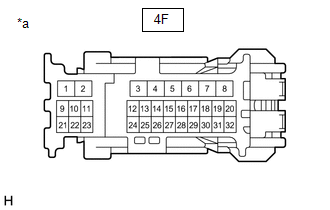 |
|
*a | Front view of wire harness connector
(to Instrument Panel Junction Block Assembly) | | |
(b) Measure the voltage according to the value(s) in the table below.
Standard Voltage:
|
Tester Connection | Condition |
Specified Condition |
|
4F-7 - Body ground | Power switch on (IG) |
11 to 14 V |
|
4F-30 - Body ground | Power switch on (IG) |
11 to 14 V |
| NG |
 | REPAIR OR REPLACE HARNESS OR CONNECTOR |
|
OK |
 | |
| 11. |
CHECK HARNESS AND CONNECTOR (INSTRUMENT PANEL JUNCTION BLOCK ASSEMBLY - ECM) |
(a) Disconnect the A19 ECM connector.
(b) Measure the resistance according to the value(s) in the table below.
Standard Resistance:
|
Tester Connection | Condition |
Specified Condition |
|
4F-20 - A19-44 (FREL) |
Always | Below 1 Ω |
|
4F-20 or A19-44 (FREL) - Body ground |
Always | 10 kΩ or higher |
| NG |
 | REPAIR OR REPLACE HARNESS OR CONNECTOR |
|
OK |
 | |
| 12. |
CHECK HARNESS AND CONNECTOR (FUEL LID LOCK WITH MOTOR ASSEMBLY - INSTRUMENT PANEL JUNCTION BLOCK ASSEMBLY AND BODY GROUND) |
(a) Disconnect the 4H instrument panel junction block assembly connector.
(b) Measure the resistance according to the value(s) in the table below.
Standard Resistance:
|
Tester Connection | Condition |
Specified Condition |
|
4H-28 - P4-1 (B) | Always |
Below 1 Ω |
|
4H-28 or P4-1 (B) - Body ground |
Always | 10 kΩ or higher |
|
P4-2 (E) - Body ground |
Always | Below 1 Ω |
| NG |
 | REPAIR OR REPLACE HARNESS OR CONNECTOR |
|
OK |
 | |
(a) Connect the A19 ECM connector.
(b) Connect the 4F and 4H instrument panel junction block assembly connectors.
(c) Measure the voltage according to the value(s) in the table below.
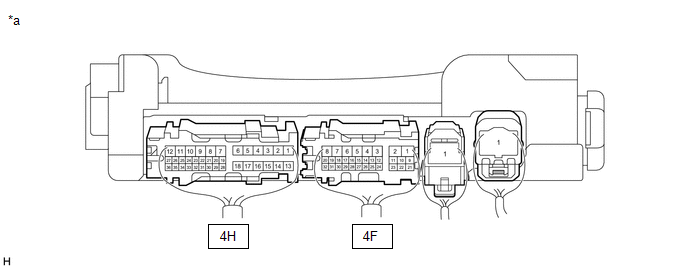
|
*a | Component with harness connected
(Instrument Panel Junction Block Assembly) |
- | - |
Standard Voltage:
|
Tester Connection | Condition |
Specified Condition |
|
4F-20 - Body ground | Power switch on (IG) and fuel lid opener switch not pressed |
11 to 14 V |
|
Power switch on (IG) and fuel lid opener switch pressed |
Below 1 V |
|
4H-28 - Body ground | Power switch on (IG) and fuel lid opener switch not pressed → fuel lid opener switch pressed |
Below 1 V → 11 to 14 V |
|
Result | Proceed to |
|
The result for terminal 4F-20 (with power switch on (IG) and fuel lid opener switch not pressed) is not as specified |
A |
| The result for terminal 4H-28 is not as specified |
|
The result for terminal 4F-20 (with power switch on (IG) and fuel lid opener switch pressed) is not as specified |
B |
| A |
 | REPLACE INSTRUMENT PANEL JUNCTION BLOCK ASSEMBLY |
| B |
 | REPLACE ECM |
How To Proceed With Troubleshooting
CAUTION / NOTICE / HINT
HINT:
- Use the following procedure to troubleshoot the fuel lid opener system.
- *: Use the Techstream.
PROCEDURE
|
1. | VEHICLE BROUGHT TO WORKSHOP |
|
NEXT |
 | |
| 2. |
CUSTOMER PROBLEM ANALYSIS |
HINT:
- In troubleshooting, confirm that the problem symptoms have been
accurately identified. Preconceptions should be discarded in order to
make an accurate judgment. To clearly understand what the problem
symptoms are, it is extremely important to ask the customer about the
problem and the conditions at the time the malfunction occurred.
- Gather as much information as possible for reference. Past problems that seem unrelated may also help in some cases.
- The following 5 items are important points for problem analysis:
|
What |
Vehicle model, system name |
|
When |
Date, time, occurrence frequency |
|
Where |
Road conditions |
|
Under what conditions? |
Driving conditions, weather conditions |
|
How did it happen? |
Problem symptoms |
|
NEXT |
 | |
(a) Measure the auxiliary battery voltage with the power switch off.
Standard Voltage:
11 to 14 V
If the voltage is below 11 V, recharge or replace the auxiliary battery before proceeding to the next step.
(b) Check the fuses and relays.
(c)
Check the connector connections and terminals to make sure that there
are no abnormalities such as loose connections, deformation, etc.
|
NEXT |
 | |
| 4. |
PROBLEM SYMPTOMS TABLE |
(a) Refer to Problem Symptoms Table.
Click here 
|
Result | Proceed to |
|
Fault is not listed in Problem Symptoms Table |
A |
| Fault is listed in Problem Symptoms Table |
B |
| B |
 | GO TO STEP 6 |
|
A |
 | |
| 5. |
OVERALL ANALYSIS AND TROUBLESHOOTING* |
(a) Data List / Active Test
Click here 
(b) Operation Check
Click here 
(c) Inspection
|
NEXT |
 | |
|
NEXT |
 | |
| NEXT |
 | END |














































